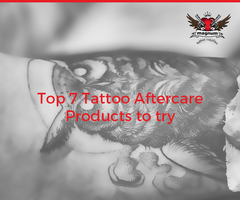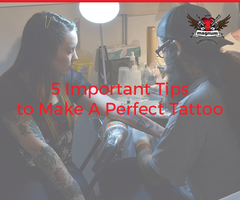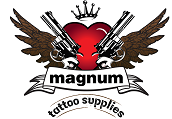Top 7 Tattoo Aftercare Products to Try 0

Maintaining the look of your tattoo may seem easy, but just like any other things... tattoos fade after a certain time. This is why manufactures in the tattoo industry came up with tattoo aftercare products to help heal your tattoo while maintaining it's vibrancy.
Here are some of the best tattoo aftercare products for healing, moisturising and enhancing the look of your tattoos.
1. Tattoo Goo original aftercare salve 3/4 Ounce tin
This aftercare product comes from 100% natural ingredients. It is made with herbs, vitamins, and oils known for their healing properties. Using this product allows the skin to breathe and soothe during your tattoo's healing process. Tattoo Goo original aftercare salve is also useful for the skin that is damaged, chapped, scraped and sun or wind burned.
2. Landerm transparent film tattoo aftercare
Landerm transparent film adhesive tattoo dressing keeps your skin away from water, germs and dust while still letting your skin breathe. It is a hypoallergenic adhesive protective barrier designed to speed up recovery of your new tattoo. It's an adhesive dressing that is also light and flexible that provides ultimate comfort. It can also be cut out to adjust to the tattoo size.
3. Ink Fixx tattoo aftercare ointment
Ink Fixx Tattoo aftercare ointment is one of the highest rated tattoo aftercare product on Amazon. It contains all of the necessary vitamins and minerals needed to allow the tattoo to heal fast and naturally. This ointment should be applied daily for your tattoo to avoid cracking, scabbing, or peeling. It also helps to avoid your tattoo’s colour to fade. It is completely based on natural ingredients, making it gentle on skin.
4. Tattoo Goo’s tattoo Kit
Getting the whole kit gives you a great deal. With an affordable price, this tattoo aftercare kit consists of five different products made by Tattoo Goo. Among these five aftercare products are moisturising lotion, soap, ointment, and a lot more. The kit is proven to be one of the best products that can heal your new tattoo. You can use it as skin moisturiser, tattoo healer, soother and infection preventer.
5. H2Ocean Extreme tattoo care kit
This product is one of the most recommended tattoo aftercare products by tattoo professionals worldwide. The 3- step ointment based system is known for its first aid healing process. Just like any other aftercare product, it keeps and protects the colour of your tattoo for a long time.
6. After Inked Tattoo Moisturiser and aftercare lotion
After Inked product is made to moisten your new and existing tattoo. This all- natural product helps your tattoo look and feel healthier. It is also non-petroleum based, paraben-free, fragrance-free, vegan, cruelty-free and gluten-free. This clinically- tested product is safe on all skin types, and is non- irritant.
7. A&D Ointment Element tattoo aftercare medical supply
Inside the package are 144 individual packs. It is used during the tattooing process as a skin moisturiser but it can also be used as a tattoo aftercare lubricant / moisturiser.
Recommended Tattoo Aftercare Tips 0

It is important for anyone to properly take care of their skin after getting a tattoo, to avoid infections and complications. Usually tattoo takes two full weeks to properly heal. The following recommended tips will help you take care and heal your fresh tattoo. By following these simple tips, your tattoo will heal at a quicker pace, look wonderful, and reduce the risks of having infections.
- What to do after getting a tattoo: After you get a tattoo, the tattoo artist will clean and bandage your tattoo. The bandage will be removed after at least 2-3 hours, or once you arrive home from the tattoo shop. The reason for this is to seal up the traumatised skin and to prevent the coming out of lymphatic fluid and blood. When it is already time for you to remove the bandage, gently wash your new tattoo by using an anti-bacterial and non-abrasive soap. Do this for at least two weeks. Using a wash cloth is prohibited unless your tattoo is already fully healed. Wash it using your hands and avoid scrubbing it. It would be better if you cover your tattoo with a loose-fitting, protective clothing, rather than having it redressed with a bandage.
- What to do during healing:
- Bathing: Careful handling of your tattoo should be done in the first 2-3 days while taking a bath. Never soak yourself in a hot tub, take a hot shower, or go to steam and sauna rooms. The hot water will open your pores and take out the impurities in your skin, including the tattoo ink pigment. Just use lukewarm water and minimise your time in the shower.
- Swimming: During the first week of your tattoo, avoid swimming, soaking yourself in a Jacuzzi or bath tub. These are possible sources of bacteria and other foreign substances that might infect your tattoo. The only time you can start swimming is when your tattoo has fully healed. Swimming while still scabbing can cause loss of pigment, which can make your tattoo look unattractive.
- Tanning/Sunlight: Eventually, your tattoos will fade. However, prolonged exposure to UV rays, will make it fade faster. Avoid too much exposure from the sun and tanning beds. In order to make your tattoo look great throughout the years, limit your exposure to direct sunlight or if it really can’t be avoided, apply sunscreen to the tattoo.
- If during the healing process your tattoo becomes irritated, red, itchy or secretes fluid, see your doctor immediately.
- How about anti-bacterial ointments? Since a tattoo is an open wound, it is more prone to bacterial infection. Taking the fundamental preventative measures and practising good hygiene will significantly reduce the chances of having serious infections. For the first 2-3 days, apply a thin layer of antibacterial ointment to the tattoo. This must be done repeatedly throughout the day in order to make sure that the tattooed area of the skin does not dry up and be infected. Bacitracin, which can be found in the first aid section of your local drugstore, is a recommended medicine. Wear loose-fitting clothes in order to allow the tattoo to breathe.
5 Important Tips to Make A Perfect Tattoo 0

A perfect tattoo isn't that easy to achieve, but with the right elements and skills, you can definitely pull off a perfect tattoo.
To accomplish this ultimate goal, keep these 5 important tips in mind.
- Listen to your client
Different clients have different tastes. Some want a detailed tattoo, while others choose simpler ones. Whatever your client prefers, listening to their wants and needs is very important. Communicating with your client is important before and during the tattoo process. Coming up with an actual design based on what they want will depend on your creativity and skills. Draft the design and show it to your client, be open to their comments. Don't hesitate to suggest an idea, if you think it will improve the design. If the design or the size is not feasible, explain it to your client, tell them the reasons why you don't recommend it, and offer them alternatives.
- Pay attention to placement
The design shouldn't be the only focus to achieve a perfect tattoo. Most of the time, clients already know the design and placement they want. As the expert, you should be able to tell whether the design and size will fit the placement they have chosen. If not, don't hesitate to tell them. You can suggest other better placements, or you can suggest adjusting the size of the design. Explain to them and show them the possible outcome if they insist the placement and size they want.
- Consider techniques in advance
Tattoo sessions are usually pre-booked, this gives you an opportunity to study and consider techniques you can use that will give you the best approach. You can even try sketching and using coloured pens to give you a better idea on how you can give justice to your client's chosen design.
- Get to know your equipment
Of course, if you're planning to make this a career you should know every equipment by heart. You should be comfortable with the equipment you will be using. Being uncomfortable with your equipment will affect the overall result of your work. Familiarise your self with all the equipment you will be using, and the brand of ink you choose to use. This will give you overall control during the tattoo process.
- Be realistic.
A good tattoo artist knows their limitations. Knowing is one thing, but admitting and accepting these limitations is different. But that shouldn't stop you from learning and practising new techniques. But if you're not ready, and you know you're not confident that you can achieve the client's desired design, say it to them directly. Accepting projects that are beyond your limitations might lead to a disastrous outcome. You don't want an unhappy client right? Be realistic and be honest. Keep in mind that customers worked hard to save money for their tattoos and they also endure the pain, so they don’t want to end up leaving your shop dissatisfied and traumatised.
Tattoo Green Soap 0

Tattoo experts and tattoo artists make use of the Tincture Green Soap – before, during, and after a tattoo procedure. This Green Soap is a therapeutic soap that is not available in local stores. It can only be purchased from medical and tattoo supply companies. The name “green soap” was formulated by tattoo artists. Tattoo artists use this by placing the soap into a spray container or bottle and then dilute it with water prior to a tattoo procedure. The spray container let the artist spread the solution to client's skin without even touching it. This is to ensure sanitation and to maintain hygiene throughout the procedure.
Tincture Green Soap disinfects and sanitises the skin of the client prior to tattooing. The tattoo artist then wipes the client's skin with disposable paper towel after spraying green soap onto the skin while wearing a fresh pair of nitrile gloves. The green soap moistens the client’s skin at the same time cleaning the area to prepare it for hair removal. While the green soap is still on the client’s skin, the tattoo artist removes the hair through shaving the body part in order to put a stop to ingrown hairs from the needle entering the skin and to have no difficulty during stencil transfer.
Subsequent to the shaving of the hair in the area where the client decided to put the tattoo, the tattoo artist will use another disposable paper towel to wipe the skin and use the green soap again to remove any loose hair. Then, the tattoo artist will spray the skin once again to moisten the clean and shaven skin. When the stencil for the tattoo design is applied, you will be asked by the artist to stand still.
What is a stencil by the way? A tattoo stencil is a sketch of your tattoo design on transfer paper, which the tattoo artist makes use of as a reference while doing your tattoo. The artist will strip the stencil paper off after a minute or two and will ask whether you approve the positioning and the size of your chosen design. If it comes to the point where the design is improperly placed or it needs to be removed due to a last minute design change, the tattoo artist will use the green soap and wipe it again with a paper towel to remove the stencil.
Green soap is free from dyes and has low alcohol content, the green soap also serves as a cleaning agent during a tattoo procedure. For the duration of your tattoo procedure, the tattoo artist will wipe the excess ink off the tattoo while performing the outline and shading. With this, the tattoo artist will be able to have a quick look to the next line in design and examine the previous lines or shading just in case additional ink is required. Once the tattoo is finished, the artist will clean excess ink, and blood using the green soap.
Taking Care of Your Tattoo over the First Week 0

Once you get a tattoo, the first week of the healing process will be very crucial. Especially the during the 2nd and 3rd days. Proper care should be done to avoid infection. You might have an idea on how to care for a fresh tattoo. But just to be sure, here are some tips you might want to take note of:
- Sleeping: One thing most people worry about after they get a tattoo is, "how do I sleep and make sure I don't scratch myself and bleed to death", of course that's exaggerated. Try not to put bandage on your tattoo at home, it needs to breathe so it can heal faster. Some people wrap their tattoos with cling wrap but only when sleeping, to ensure that they avoid scratching it while they're asleep. If in case you decide not to wrap your tattoo while sleeping, and you wake up with the sheets sticking on your tattoo, please don't try to peel it off. Take the sheet with you to the shower and gently wet the area with cool water, then gently remove it from being stuck.
- Never ever pick scabs. Over the next couple of days, you will be able to notice some scabs forming on your tattoo. This is definitely normal. However, heavy scabbing is out of the ordinary and need to be watched closely. One of the most important things to remember here is that you must not try to pick your scabs, no matter how small it is. Let it fall off on its own over time or during the cleaning process. Picking scabs can scar your skin and ruin your tattoo for the rest of your life. You don’t want that to happen right? Another thing that can happen is your tattoo peeling off while you put an ointment or while you are cleaning it. Remember to clean and put after care solutions gently to avoid ruining your tattoo. Keep your hands clean before applying any ointment or before touching your tattoo. Peeling is also normal and might take about 4 to 10 days. After that, you will be able to see the colours coming back. On the fourteenth day, your tattoo should be fully healed.
- Clothing: Another big factor you need to consider is your clothing. Your clothing can also affect your healing process. You will need to wear loose fitting clothes depending on where the tattoo placement is. Always remember that your tattoo needs to breathe. Never wear tight fitting clothes especially the ladies. Another issue is that if you continue on wearing tight fitting clothes and it rubs the scab, it might peel off and cause infection. Infection not only slows down the healing process, it can also cause the wound to develop pus. It can cause ugly scarring and light spots on your tattoo.
6 Things You Need to Know About Tattoo Goo - Buy Tattoo Goo Aftercare 0







